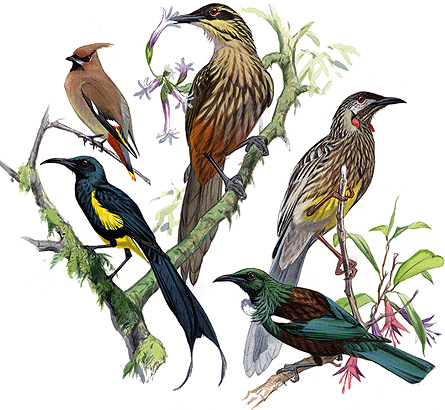Five species of Hawaiian birds have made fools of taxonomists for more than 200 years, thanks to a fine bit of evolutionary illusion-making.

O‘o and kioea birds, now extinct, specialized in feeding on flower nectar using long, curved bills and split tongues tipped with brushes or fringe. Since Captain Cook’s expedition introduced the birds to western science, they have been classified in the honeyeater family with similar-looking nectar sippers living in New Guinea and Australia.
DNA from museum specimens of the Hawaiian species shows that the birds weren’t a kind of honeyeater at all, according to Robert Fleischer of the Smithsonian Institution in Washington, D.C. Instead the Hawaiians’ resemblance to the western Pacific birds offers a new and dramatic example of how evolution within different lineages can converge on similar forms for similar jobs, he and his colleagues report online December 11 in Current Biology.
O‘os and the kioea weren’t even closely related to the honeyeaters of the western Pacific, Fleischer says. The closest relatives of Hawaii’s so-called honeyeaters were waxwings, silky flycatchers and the palmchat. These kin live mostly in the Americas and use tongues of unexciting shapes to eat bugs and berries. In the United States, the cedar waxwing and the Southwest’s phainopepla may be the best-known examples.
“It’s like we had this animal we always thought was a dog, and it’s turned out to be a mongoose,” Fleischer says.
Genetic evidence suggests that some ancestral relative of the waxwing group arrived in Hawaii between about five and 14 million years ago, Fleischer says. Living the island life, the ancestral birds shifted to nectar feeding and evolved body forms like the honeyeaters. All the birds with similar shapes and habits looked like kin to ornithologists.
Their degree of convergence is “remarkable,” in the words of Keith Barker of the University of Minnesota’s Bell Museum in Minneapolis. He’s working with DNA that uncovered another long-lost relative of the waxwings, living among southeast Asian birds. “This was shocking to us, but not nearly as startling as Fleischer’s finding,” he says.
Discovering the mainland connection for Hawaii’s o‘os and kioea adds yet another animal group to the list of immigrants from the Americas that colonized Hawaii, Barker says. Yet, excepting the mints and silverswords, a lot of Hawaii’s plants seem to have come from the opposite direction, from the South Pacific.
While living in Hawaii, the new nectar feeders diversified into four o‘o species, each on a different island, with the kioea residing on the Big Island.Lemon-colored patches in o‘o plumage supplied brilliant yellow feathers for island royalty’s ceremonial capes and headdresses.
The kioea disappeared first, during the 1850s. O‘os hung on longer. The last of the species, Kauai’s, hasn’t been seen since 1985. “I just missed it,” says Fleischer, who moved to Hawaii that year.
Kioeas and o‘os deserve a family of their own, Fleischer and his colleagues contend. Thus, even before it was named, the newly christened Mohoidae became the only bird family that disappeared without a survivor in the last hundred years.






